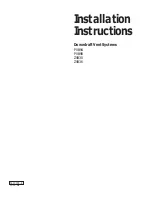
Water Treatment
Proper water treatment is a specialized industry. IEC
recommends consulting an expert in this field to analyze
the water for compliance with the water quality parameters
listed below, and to specify the appropriate water treatment
regimen. The expert may recommend typical additives such
as rust inhibitors, scaling preventative, antimicrobial growth
agents, or algae preventatives. Anti-freeze solutions may also
be used to lower the freezing point.
IEC water coil tubes and headers are constructed of pure
copper. Multiple brass alloys may be present in the valve
package, depending on unit configuration. It is the user’s
responsibility to ensure the tube and piping materials
furnished by IEC, are compatible with the treated water.
Failure to provide proper water quality may affect the
fan coil unit’s warranty.
Water Containing
Required Concentration
Sulphate
Less than 200 ppm
pH
7.0 – 8.5
Chlorides
Less than 200 ppm
Nitrate
Less than 100 ppm
Iron
Less than 4.5 mg/l
Ammonia
Less than 2.0 mg/l
Manganese
Less than 0.1 mg/l
Dissolved Solids
Less than 1000 mg/l
CaCO3 Hardness
300 - 500 ppm
CaCO3 Alkalinity
300 - 500 ppm
Particulate Quantity
Less than 10 ppm
Particulate Size
800 micron max
Water System Balancing
A complete knowledge of the hydronic system, along with
its components and controls, is essential to proper water
system balancing. This procedure should not be attempted
by unqualified personnel. The system must be complete,
and all components must be in operating condition
BEFORE
beginning water system balancing operations.
Each hydronic system has different operating characteristics
depending on the devices and controls used in the system.
The actual balancing technique may vary from one system to
another.
After the proper system operation is established, the
appropriate system operating conditions such as various
water temperatures and flow rates should be recorded in a
convenient place for future reference.
Before and during water system balancing, conditions may
exist due to incorrect system pressures which may result in
noticeable water noise or undesired valve operation. After
the entire system is balanced, these conditions will not exist
on properly designed systems.
Controls Operation
Before proper control operation can be verified, all other
systems must be operating properly. The correct water and
air temperatures must be present for the control function
being tested. Some controls and features are designed to
not operate under certain conditions. For example, on a
two-pipe cooling/heating system with auxiliary electric heat,
the electric heater cannot be energized with hot water in the
system.
A wide range of controls, electrical options and accessories
may be used with the equipment covered in this
manual. Consult the approved unit submittals, order
acknowledgements, and other literature for detailed
information regarding each individual unit and its controls.
Since controls and features may vary from one unit to
another, care should be taken to identify the controls used
on each unit and their proper control sequence. Information
provided by component manufacturers regarding
installation, operation, and maintenance of their individual
controls is available upon request.
When changing from one mode to another (cooling to
heating or heating to cooling), it may take some time to
actually notice a change in the leaving air temperature.
In addition, some units may be designed for a very low
air temperature rise in heating. Before declaring a unit
inoperative or a component defective, it may be necessary to
verify operation by more than one method.
21
Modular Hi-Rise Series Fan Coils
INSTALLATION, OPERATION, & MAINTENANCE MANUAL
Содержание MAY
Страница 27: ...This page was intentionally left blank ...








































